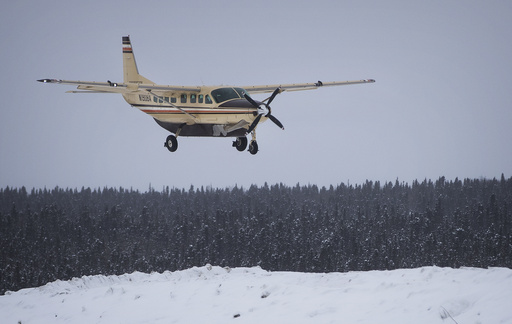
JUNEAU, Alaska — The wreckage of a missing plane was discovered on sea ice, matching the description of an aircraft that vanished while en route to Nome, carrying ten individuals. Authorities confirmed on Friday that three bodies were located inside the plane.
Cameron Snell, a representative for the U.S. Coast Guard, stated that search teams had not yet gained full access to the aircraft, but the recovery efforts were ongoing. “At this moment, our knowledge is limited to the discovery of three bodies,” he commented.
According to Mike Salerno, another Coast Guard representative, rescuers were surveying the plane’s last known coordinates via helicopter when they noticed the wreckage and deployed two rescue swimmers for a closer inspection.
The Bering Air single-engine turboprop aircraft was journeying from Unalakleet on Thursday afternoon, carrying a pilot and nine passengers, as reported by the Alaska Department of Public Safety. The Cessna Caravan took off at 2:37 p.m. and officials lost track of it shortly thereafter, approximately an hour later. David Olson, who oversees operations for Bering Air, mentioned that conditions included light snowfall and fog with a temperature of 17 degrees Fahrenheit (approximately minus 8.3 degrees Celsius).
The Coast Guard noted the plane’s last known location was about 30 miles (48 kilometers) southeast of Nome and around 12 miles (19 kilometers) offshore. Bering Air later indicated that the flight was fully booked.
Data from radar forensics provided by the U.S. Civil Air Patrol indicated that at approximately 3:18 p.m. on Thursday, the aircraft experienced a significant incident leading to a rapid decline in both altitude and speed, according to Coast Guard Lieutenant Commander Benjamin McIntyre-Coble. “What type of event occurred is still uncertain,” he said.
Furthermore, McIntyre-Coble stated he was not aware of any distress signals being sent from the plane. Normally, aircraft are equipped with emergency location transmitters that activate upon contact with seawater, sending distress signals to satellites that relay information to the Coast Guard. As of now, no such signals have been received.
All ten individuals aboard were adults, and the flight constituted a routine commuter service, noted Lieutenant Ben Endres of the Alaska State Troopers. This incident represents the third significant aviation disaster in the U.S. within the past eight days, following a fatal collision between a commercial jetliner and an Army helicopter that resulted in 67 fatalities, and a medical transport plane crash in Philadelphia claiming six lives and one ground casualty.
In rural Alaska, where most communities are not linked to the primary road network, air travel is often the only viable option, particularly in winter months. The region frequently encounters sudden snowstorms and strong winds, prompting officials to warn locals against forming their own search teams due to hazardous weather conditions.
Bering Air provides transportation services to 32 villages in western Alaska, operating from hubs located in Nome, Kotzebue, and Unalakleet. Typically, most destinations receive scheduled flights twice a day from Monday to Saturday. Observers noted two Bering Air aircraft performing a grid search just offshore on Friday morning, using flight tracking service Flightradar24.
The search operation involved multiple agencies at the local, state, and federal levels, with teams scouring stretches of frozen tundra and sea-ice dotted waters. A helicopter from the National Guard was authorized for aerial assistance on Friday morning, with the Coast Guard and other agencies also participating in the aerial reconnaissance. Additionally, the Coast Guard planned to deploy a buoy for tracking sea ice movement, while ground crews on snowmobiles surveyed the coastline retreating further inland.
Unalakleet, a settlement of about 690 residents, is situated approximately 150 miles (about 240 kilometers) southeast of Nome and 395 miles (around 640 kilometers) northwest of Anchorage. This village lies along the Iditarod trail, the famous route of the renowned sled dog race, where participants must traverse the frozen Norton Sound.
Nome, known historically for its Gold Rush roots, is located just south of the Arctic Circle and recognized as the endpoint of the Iditarod trail covering 1,000 miles (1,610 kilometers). The city announced that prayer vigils would be held on Friday for the individuals on board the flight, as well as for their families and those involved in the search efforts.
Alaska’s U.S. senators, Lisa Murkowski and Dan Sullivan, expressed their condolences and solidarity with the passengers’ families and the rescue teams in statements. U.S. Representative Nick Begich also reached out on the social media platform X, emphasizing his willingness to support Nome and collaborate with Alaska Governor Mike Dunleavy.

